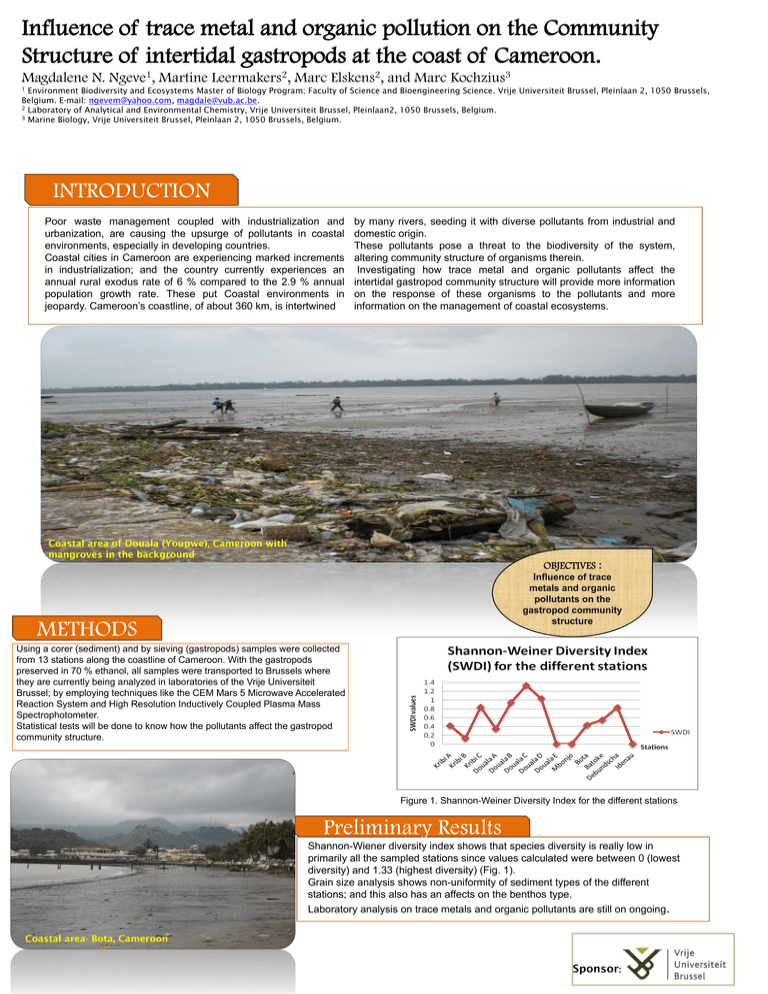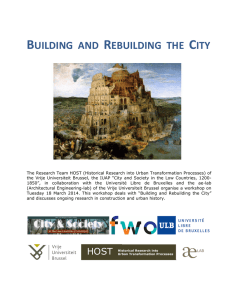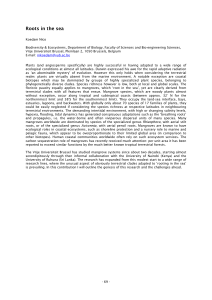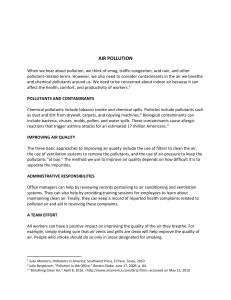Influence of trace metal and organic pollution on the Community
advertisement

Influence of trace metal and organic pollution on the Community Structure of intertidal gastropods at the coast of Cameroon. Magdalene N. 1 Ngeve , Martine 2 Leermakers , Marc 2 Elskens , and Marc 3 Kochzius Environment Biodiversity and Ecosystems Master of Biology Program; Faculty of Science and Bioengineering Science. Vrije Universiteit Brussel, Pleinlaan 2, 1050 Brussels, Belgium. E-mail: ngevem@yahoo.com, magdale@vub.ac.be. 2 Laboratory of Analytical and Environmental Chemistry, Vrije Universiteit Brussel, Pleinlaan2, 1050 Brussels, Belgium. 3 Marine Biology, Vrije Universiteit Brussel, Pleinlaan 2, 1050 Brussels, Belgium. 1 INTRODUCTION Poor waste management coupled with industrialization and urbanization, are causing the upsurge of pollutants in coastal environments, especially in developing countries. Coastal cities in Cameroon are experiencing marked increments in industrialization; and the country currently experiences an annual rural exodus rate of 6 % compared to the 2.9 % annual population growth rate. These put Coastal environments in jeopardy. Cameroon’s coastline, of about 360 km, is intertwined by many rivers, seeding it with diverse pollutants from industrial and domestic origin. These pollutants pose a threat to the biodiversity of the system, altering community structure of organisms therein. Investigating how trace metal and organic pollutants affect the intertidal gastropod community structure will provide more information on the response of these organisms to the pollutants and more information on the management of coastal ecosystems. Coastal area of Douala (Youpwe), Cameroon with mangroves in the background OBJECTIVES : Influence of trace metals and organic pollutants on the gastropod community structure METHODS Using a corer (sediment) and by sieving (gastropods) samples were collected from 13 stations along the coastline of Cameroon. With the gastropods preserved in 70 % ethanol, all samples were transported to Brussels where they are currently being analyzed in laboratories of the Vrije Universiteit Brussel; by employing techniques like the CEM Mars 5 Microwave Accelerated Reaction System and High Resolution Inductively Coupled Plasma Mass Spectrophotometer. Statistical tests will be done to know how the pollutants affect the gastropod community structure. Figure 1. Shannon-Weiner Diversity Index for the different stations Preliminary Results Shannon-Wiener diversity index shows that species diversity is really low in primarily all the sampled stations since values calculated were between 0 (lowest diversity) and 1.33 (highest diversity) (Fig. 1). Grain size analysis shows non-uniformity of sediment types of the different stations; and this also has an affects on the benthos type. Laboratory analysis on trace metals and organic pollutants are still on ongoing. Coastal area- Bota, Cameroon Sponsor:




